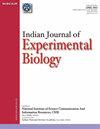Abelmoschus esculentus (L.) Moench seed extract alleviates acute acetaminophen induced liver damage in rats
IF 0.7
4区 生物学
Q4 BIOLOGY
引用次数: 0
Abstract
Acetaminophen (APAP) is one of the most regularly utilized medicines in children. When administered at the recommended doses, it is a safe medication. However, oxidative stress and inflammation caused by exposure to toxic doses lead to centrilobular hepatic necrosis. N-acetylcysteine (NAC) is utilized in the therapy, however it has potentially adverse effects. On the other hand, it is known that the seed of Abelmoschus esculentus (AE), a herbal product, possesses antioxidant and anti-inflammatory qualities. The aim of this study is to investigate whether AE may be used as an alternative to standart NAC therapy without fear of adverse effects in the treatment of acute APAP-induced liver injury. Forty male Wistar rats were placed into five groups: Control, AE, APAP, APAP+AE, and APAP+AE+NAC groups. Antioxidants such as native thiol and total thiol can be raised in the APAP group by taking just AE (p=0.043 and p=0.028, respectively). Anti-inflammatory indicators such as IL-10 can be increased in this group, while markers such as ALT, which is a sign of hepatotoxicity, can be decreased (p=0.005 and p<0.001, respectively). Histologically, AE has been shown to improve worsened congestion (p=0.003), cytoplasmic vacuolization (p=0.01), sinusoidal dilatation (p=0.001), Kupffer cell proliferation (p<0.001), and inflammation (p<0.001). These results suggest that AE seed may be a potential therapeutic agent for APAP-induced hepatotoxicity. The antioxidant and anti-inflammatory properties of AE seed contribute to this advantage.绿毛鼠(L.)芒硝子提取物减轻对乙酰氨基酚所致大鼠急性肝损伤
对乙酰氨基酚(APAP)是儿童最常用的药物之一。按推荐剂量服用时,它是一种安全的药物。然而,暴露于有毒剂量引起的氧化应激和炎症可导致小叶中心肝坏死。n -乙酰半胱氨酸(NAC)用于治疗,但它有潜在的副作用。另一方面,众所周知,草籽(AE)是一种草药产品,具有抗氧化和抗炎的特性。本研究的目的是探讨在急性apap诱导的肝损伤治疗中,AE是否可以作为标准NAC治疗的替代方案,而无需担心不良反应。将40只雄性Wistar大鼠分为5组:对照组、AE组、APAP组、APAP+AE组和APAP+AE+NAC组。仅服用AE可提高APAP组抗氧化剂的天然硫醇和总硫醇含量(p=0.043和p=0.028)。IL-10等抗炎指标升高,ALT等肝毒性指标降低(p=0.005, p= 0.001)。组织学上,AE已被证明可以改善恶化的充血(p=0.003)、细胞质空泡化(p=0.01)、窦状窦扩张(p=0.001)、库普弗细胞增殖(p=0.001)和炎症(p=0.001)。这些结果表明,AE种子可能是apap诱导的肝毒性的潜在治疗剂。AE种子的抗氧化和抗炎特性有助于这一优势。
本文章由计算机程序翻译,如有差异,请以英文原文为准。
求助全文
约1分钟内获得全文
求助全文
来源期刊
CiteScore
1.57
自引率
33.30%
发文量
84
审稿时长
6 months
期刊介绍:
This journal, started in 1963, publishes full papers, notes and reviews in cell biology, molecular biology, genetic engineering, endocrinology, reproductive biology, immunology, developmental biology, comparative physiology, radiation biology, chronobiology, microbiology, pharmacology, toxicology and other biological fields including instrumentation and methodology. The papers having experimental design involving alteration and/or manipulation in biological system(s) providing insight into their functioning are considered for publication. Studies involving higher animals, human beings and of clinical nature are not encouraged for publication in the journal.

 求助内容:
求助内容: 应助结果提醒方式:
应助结果提醒方式:


